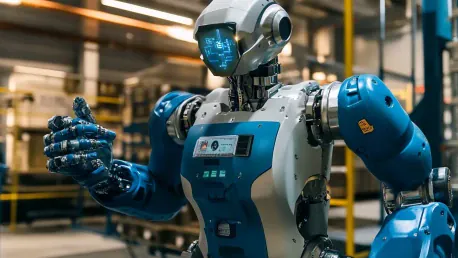Robot Era, a trailblazer in the robotics industry, has unveiled the ERA-42, an advanced end-to-end large computing model designed for general-purpose robotics. This groundbreaking development marks a significant leap in robotic dexterity and intelligence, setting a new industry standard. The ERA-42’s innovative features and capabilities promise to revolutionize various sectors by enhancing the adaptability and intelligence of robotic systems. This model’s introduction into the market is poised to transform industries by pushing robots towards unprecedented levels of performance, making them more versatile and capable of completing an array of complex tasks efficiently and effectively.
Unprecedented Dexterity and Precision
At the heart of the ERA-42’s innovation is its integration with the self-developed XHand1, a sophisticated five-finger dexterous hand. This combination represents a world-first achievement in robotics, enabling the model to perform over 100 intricate tasks with human-like flexibility and precision. Tasks such as tightening screws, hammering nails, righting overturned cups, and pouring liquids demonstrate the model’s exceptional dexterity and operational capabilities. The precise and adaptable nature of XHand1 ensures that these tasks are completed efficiently, reducing the margin for error, and increasing productivity in intricate operations.
The XHand1’s ability to execute these complex actions with high levels of adaptability and precision showcases the ERA-42’s potential to handle delicate and intricate tasks. This advancement is particularly significant for industries requiring meticulous operations, such as healthcare and precision manufacturing, where the ERA-42 can significantly enhance productivity and efficiency. By applying this level of dexterity, healthcare providers can rely on robots for surgeries or other sensitive tasks, while manufacturers can achieve faster assembly with higher precision, thereby reducing production costs and improving product quality.
Rapid Skill Acquisition and Adaptability
A standout feature of the ERA-42 is its robust generalization and adaptability, which eliminates the need for pre-programmed skills. The model can learn new tasks within two hours, expanding its utility across diverse applications, from manufacturing and healthcare to service industries. This capacity for rapid skill acquisition allows the ERA-42 to quickly adapt to unforeseen challenges, manage delicate materials, and perform repetitive tasks efficiently, reducing operational downtime. The ability to swiftly learn and apply new skills positions the ERA-42 as a versatile tool in dynamic industries, allowing businesses to stay ahead in an ever-evolving technological landscape.
The model’s ability to generalize tasks across various environments is achieved through the integration of vision, language, touch, and body posture into a single model. This unified generalization enables the ERA-42 to operate seamlessly in different settings, enhancing its versatility and making it a valuable asset in multiple sectors. From recognizing objects and understanding commands to adapting to different environments, the ERA-42 showcases the potential of truly intelligent robotic systems capable of executing a wide range of tasks with minimal human intervention.
End-to-End Design and Scalability
The ERA-42 exemplifies critical elements that define a “true” embodied large model: unified generalization, end-to-end design, and scalability. The end-to-end design employs a streamlined neural network for real-time adaptability without requiring manual feature design or pre-programming. This approach allows for seamless operation and continuous improvement through data accumulation, enhancing the model’s performance and adaptability to new, unknown tasks. By continuously learning from experience and data, ERA-42 ensures that it remains at the cutting edge of robotic capability, constantly improving its functionality and efficiency.
Scalability is a key aspect of the ERA-42, as it continuously iterates through data accumulation, improving its capabilities and expanding its range of applications. This feature positions the ERA-42 as a cornerstone of next-generation robotics, contributing to a paradigm shift from task-specific robots to versatile, multi-task systems. The ability to scale and adapt in real-time without significant manual intervention marks a significant departure from traditional robotic systems, paving the way for more integrated and autonomous solutions that can handle complex, multifaceted tasks across various industries.
Innovative Training Methodologies
Robot Era has introduced innovative training methodologies for the ERA-42, utilizing large-scale video datasets, including unlabeled videos, human activity data, and teleoperation data. By focusing on understanding the causal relationships behind actions and their outcomes, rather than merely mimicking actions, the ERA-42 ensures robust generalization across real-world scenarios. This approach reduces data collection costs and addresses the challenge of dependency on high-quality data, advancing the creation of truly autonomous systems. Such innovative training techniques ensure that the ERA-42 can learn effectively from diverse types of data, further enhancing its adaptability and operational capability in numerous real-world applications.
This approach leverages the power of large datasets to better understand the intricacies of human actions and their results, ensuring that the model can apply this understanding in practical scenarios. The ERA-42’s ability to understand and predict outcomes enhances its adaptability and performance, making it a valuable tool for various industries. By moving beyond simple imitation to a deeper comprehension of tasks and environments, the ERA-42 stands as a testament to the progress in creating more intelligent, autonomous systems that can better assist and work alongside humans in complex, real-world settings.
Integration With World Model
An integral component of the ERA-42 is its incorporation into a world model, which allows the system to understand physical environments and predict outcomes. This integration enhances the model’s ability to quickly adapt to external disturbances during tasks, ensuring smooth performance even in complex operations. For example, the XHand1, when equipped with the ERA-42, can autonomously optimize movements and adjust to complete tasks even when objects are moved. This superior anti-interference capability showcases the ERA-42’s potential to handle dynamic and unpredictable environments, further expanding its range of applications.
By embedding the ERA-42 in a comprehensive world model, Robot Era ensures that the robot can effectively navigate and interact with its surroundings, making real-time adjustments as needed. This capability is particularly valuable in environments where conditions can change unexpectedly, such as in manufacturing or healthcare settings. The ability to predict and respond to changes ensures that the ERA-42 maintains high efficiency and productivity, reducing the likelihood of errors and improving overall operational outcomes.
Broad Implications Across Industries
Robot Era, a leader in the robotics field, has introduced the ERA-42, an advanced end-to-end large computing model designed for general-purpose robotics. This groundbreaking model marks a significant advancement in both robotic dexterity and intelligence, setting a brand-new industry benchmark. The innovative features and capabilities of the ERA-42 promise to revolutionize various sectors by enhancing the adaptability and intelligence of robotic systems. The release of this model is expected to transform industries by pushing the performance of robots to unprecedented levels. These enhancements will make robots more versatile and capable of efficiently and effectively completing a wide array of complex tasks. The ERA-42’s advanced computing power and refined capabilities will enable it to adapt to different environments and tasks more seamlessly than ever before. This leap forward is set to benefit not just manufacturing, but also healthcare, logistics, and many other sectors, making the ERA-42 a cornerstone in the next generation of intelligent robotic systems.









